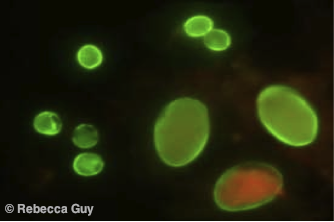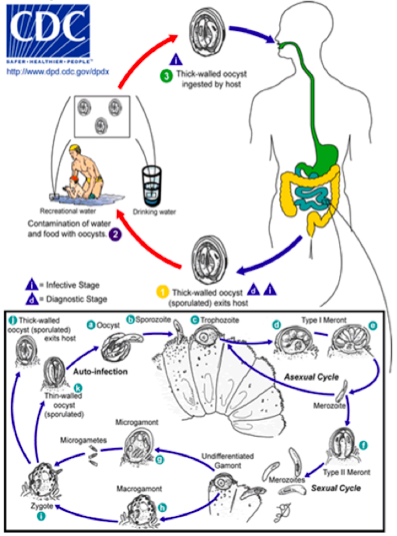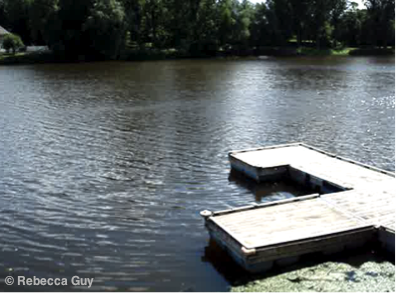Cryptosporidium spp.
Contributor: Rebecca Guy
Biology: Cryptosporidium is a coccidian parasite that was first described in mice in 1907, and the first reported human case was in 1976. It comprises over 20 species and over 40 genotypes found in mammals, birds, reptiles, amphibians and fish. The majority of human infections are caused by C. hominis (mainly in humans) and C. parvum (in humans and cattle). The main reservoir of zoonotic Cryptosporidium is livestock. Minor species infecting humans are C. meleagridis, C. canis, C. felis, C. muris and C. suis.

Figure 1. Cryptosporidium oocysts (4-6 µm) mainly on the left and the larger Giardia cysts (9-14 µm) on the right.
Life Cycle: The transmission stage is the oocyst which is shed in the faeces. Oocysts can survive in the environment for 1 month to 1 year and are very resistant to disinfection. Ingestion of oocysts initiates a new infection.

Figure 2. Cryptosporidium spp. life cycle (Source: CDC).
Transmission: Cryptosporidium is transmitted through water, food and direct person to person, or person to animal contact. Water is the major route of transmission, through use of contaminated drinking water and recreational water, including swimming pools and waterparks.

Figure 3. Recreational water is a major transmission route for Cryptosporidium spp.
Prevalence: Cryptosporidium is endemic worldwide. Prevalence is 0.1-9% in developed countries and 10-28% in developing countries.
Susceptible Populations: Immune-compromised, elderly, and malnourished individuals
Symptoms: Watery diarrhea, cramps, fatigue, nausea, vomiting, fever, weight loss
Treatment: Most healthy individuals will resolve the infection without treatment. Rehydration salts maybe required. Nitazoxanide is the only FDA-approved drug for treatment of infection.
Control Measures: Control measures to prevent infection include washing of produce and hand washing after contact with human and animal faeces, and before food preparation or eating. Avoid swimming when experiencing diarrhea. Do not drink inadequately treated water.